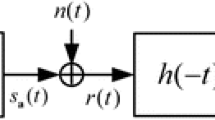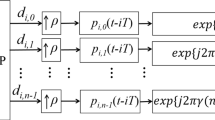Abstract
In this paper, a novel shaping pulse called root better pulse in faster-than-Nyquist (FTN) system is proposed. Compared to the conventional root raised cosine pulse in FTN system with roll factor 0.1, when bit error rate (BER) is \(10^{-5}\), the proposed root better pulse in FTN system can obtain 0.65 dB and 0.60 dB performance gain for time packing factor at 0.85 and 0.90, respectively. The theoretical average mutual information analysis and simulated BER results both show that the proposed root better pulse in FTN system is an efficient scheme.





Similar content being viewed by others
References
Nguyen, D. C., et al. (2022). 6G internet of things: A Comprehensive Survey. IEEE Internet of Things Journal, 9(1), 359–383.
Mao, T., & Wang, Z. (2021). Terahertz wireless communications with flexible index modulation aided pilot design. IEEE Journal on Selected Areas in Communications, 39(6), 1651–1662.
You, L., Xiong, J., Ng, D. W. K., Yuen, C., Wang, W., & Gao, X. (2021). Energy efficiency and spectral efficiency tradeoff in RIS-aided multiuser MIMO uplink transmission. IEEE Transactions on Signal Processing, 69, 1407–1421.
Chen, S., Liang, Y.-C., Sun, S., Kang, S., Cheng, W., & Peng, M. (2020). Vision, requirements, and technology trend of 6G: How to tackle the challenges of system coverage. Capacity, User Data-Rate and Movement Speed, in IEEE Wireless Communications, 27(2), 218–228.
Mazo, J. E. (1975). Faster-than-Nyquist signaling. Bell System Technical Journal, 54(8), 1451–1462.
Anderson, J. B., Rusek, F. & Wall, V. (2013). Faster-than-Nyquist signaling. In: Proceedings of the IEEE (Vol. 101, no. 8, pp. 1817–1830).
Liveris, A. D., & Georghiades, C. N. (2003). Exploiting faster-than-Nyquist signaling. IEEE Transactions on Communications, 51(9), 1502–1511.
Rusek, F., & Anderson, J. B. (2008). Non binary and precoded faster than Nyquist signaling. IEEE Transactions on Communications, 56(5), 808–817.
Rusek, F., & Anderson, J. B. (2009). Constrained capacities for faster-than-Nyquist signaling. IEEE Transactions on Information Theory, 55(2), 764–775.
Fan, J., Guo, S., Zhou, X., Ren, Y., Li, G. Y., & Chen, X. (2017). Faster-than-Nyquist signaling: an overview. IEEE Access, 5, 1925–1940.
Zhou, J., Li, D., Wang, X., & Generalized faster-than-Nyquist signaling,. (2012). IEEE international symposium on information theory proceedings. Cambridge, MA, 2012 (pp. 1478–1482).
Song, P., Gong, F., Li, Q., Li, G., & Ding, H. (2020). Receiver design for faster-than-Nyquist signaling: Deep-learning-based architectures. IEEE Access, 8, 68866–68873.
Mingqi, L., Yaqiu, P., Shihao, L., & Jingfeng, T. (2017). A DFT based block transmission scheme for FTN signaling. In: 2017 23rd Asia-Pacific conference on communications (APCC) (pp. 1–6).
Li, S., Yuan, W., Yuan, J., Bai, B., Wing Kwan Ng, D., & Hanzo, L. (2020). Time-domain vs. frequency-domain equalization for FTN signaling. IEEE Transactions on Vehicular Technology, 69(8), 9174–9179.
Ishihara, T., Sugiura, S., & Hanzo, L. (2021). The evolution of faster-than-Nyquist signaling. IEEE Access, 9, 86535–86564.
Ishihara, T., & Sugiura, S. (2022). Reduced-complexity FFT-spread multicarrier faster-than-Nyquist signaling in frequency-selective fading channel. IEEE Open Journal of the Communications Society, 3, 530–542.
Barbieri, A., Fertonani, D., & Colavolpe, G. (2009). Time-frequency packing for linear modulations: spectral efficiency and practical detection schemes. IEEE Transactions on Communications, 57(10), 2951–2959.
Forney, G. (1972). Maximum-likelihood sequence estimation of digital sequences in the presence of intersymbol interference. IEEE Transactions on Information Theory, 18(3), 363–378.
Rusek, F., Colavolpe, G., & Sundberg, C. E. W. (2015). 40 Years with the ungerboeck model: a look at its potentialities [lecture notes]. IEEE Signal Processing Magazine, 32(3), 156–161.
Colavolpe, G., & Barbieri, A. (2005). On MAP symbol detection for ISI channels using the ungerboeck observation model. IEEE Communications Letters, 9(8), 720–722.
Nyquist, H. (1928). Certain topics in telegraph transmission theory. Transactions of the American Institute of Electrical Engineers, 47(2), 617–644.
Beaulieu, N. C., Tan, C. C., & Damen, M. O. (2001). A better than Nyquist pulse. IEEE Communications Letters, 5(9), 367–368.
Assalini, A., & Tonello, A. M. (2004). Improved Nyquist pulses. IEEE Communications Letters, 8(2), 87–89.
Caire, G., Taricco, G., & Biglieri, E. (1998). Bit-interleaved coded modulation. IEEE Transactions on Information Theory, 44(3), 927–946.
Arnold, D. M., Loeliger, H. A., Vontobel, P. O., Kavcic, A., & Zeng, W. (2006). Simulation-based computation of information rates for channels with memory. IEEE Transactions on Information Theory, 52(8), 3498–3508.
Piemontese, A., Modenini, A., Colavolpe, G., & Alagha, N. S. (2013). Improving the spectral efficiency of nonlinear satellite systems through time-frequency packing and advanced receiver processing. IEEE Transactions on Communications, 61(8), 3404–3412.
Che, H., Wu, Z., Kang, W., Optimization, inner code, & for high rate faster-than-Nyquist,. (2019). IEEE wireless communications and networking conference (WCNC). Marrakesh, Morocco, 2019 (pp. 1–6).
Kang, W., & Wu, Z. (2020). Probabilistic Shaping in Faster-Than-Nyquist System. IEEE Wireless Communications and Networking Conference Workshops (WCNCW), 2020, 1–6.
Kang, W., Che, H., & Zhu, K. (2020). Precoding Optimization for Faster-Than-Nyquist Signaling With Probabilistic Shaping. IEEE Transactions on Vehicular Technology, 69(10), 11470–11478.
Author information
Authors and Affiliations
Corresponding author
Ethics declarations
Conflict of interest
On behalf of all authors, the corresponding author states that there is no conflict of interest.
Declarations
Please note that submissions that do not include required statements will be returned as incomplete.
Additional information
Publisher's Note
Springer Nature remains neutral with regard to jurisdictional claims in published maps and institutional affiliations.
Rights and permissions
Springer Nature or its licensor holds exclusive rights to this article under a publishing agreement with the author(s) or other rightsholder(s); author self-archiving of the accepted manuscript version of this article is solely governed by the terms of such publishing agreement and applicable law.
About this article
Cite this article
Kang, W. A novel shaping pulse in faster-than-Nyquist system. Telecommun Syst 81, 333–340 (2022). https://doi.org/10.1007/s11235-022-00949-4
Accepted:
Published:
Issue Date:
DOI: https://doi.org/10.1007/s11235-022-00949-4




